Healthcare Information Management: Challenges and Solutions Report
VerifiedAdded on 2023/01/16
|8
|1953
|32
Report
AI Summary
This report delves into the critical aspects of healthcare information management, examining key challenges and potential solutions within the field. The report begins by exploring Electronic Health Records (EHRs), discussing their benefits but also addressing the difficulties of integrating behavioral health and primary care, proposing collaboration between vendors and clinicians as a solution. The report then analyzes HL7 and interoperability, highlighting the lack of central monitoring as a challenge, and suggesting real-time data capabilities as a solution. The report then discusses the Health Insurance Portability and Accountability Act (HIPAA), focusing on the challenge of secure passwords and recommending password management policies. Health Information Technology is also examined, with the challenge of rapid technological advancements addressed through the need for tech-savvy professionals. Furthermore, the report investigates the correlation between health information technologies and patient satisfaction, addressing the challenge of sharing patient data. Lastly, the report examines telehealth and healthcare technology innovators, highlighting the challenge of licensing and proposing the development of unions to facilitate smooth operations across borders. The report concludes with an emphasis on the importance of effective patient data management and the need for privacy, confidentiality, and honesty within healthcare institutions.
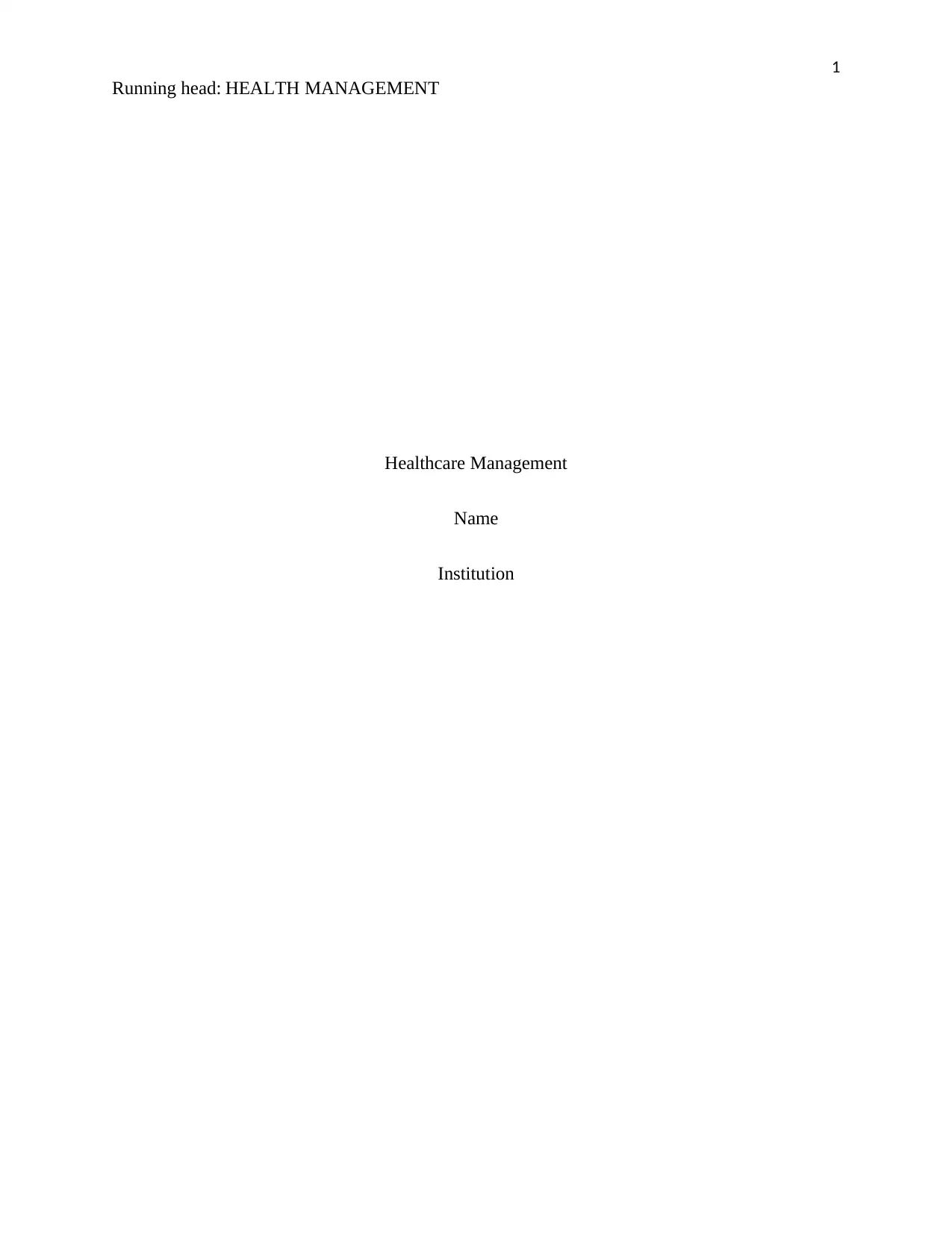
1
Running head: HEALTH MANAGEMENT
Healthcare Management
Name
Institution
Running head: HEALTH MANAGEMENT
Healthcare Management
Name
Institution
Paraphrase This Document
Need a fresh take? Get an instant paraphrase of this document with our AI Paraphraser
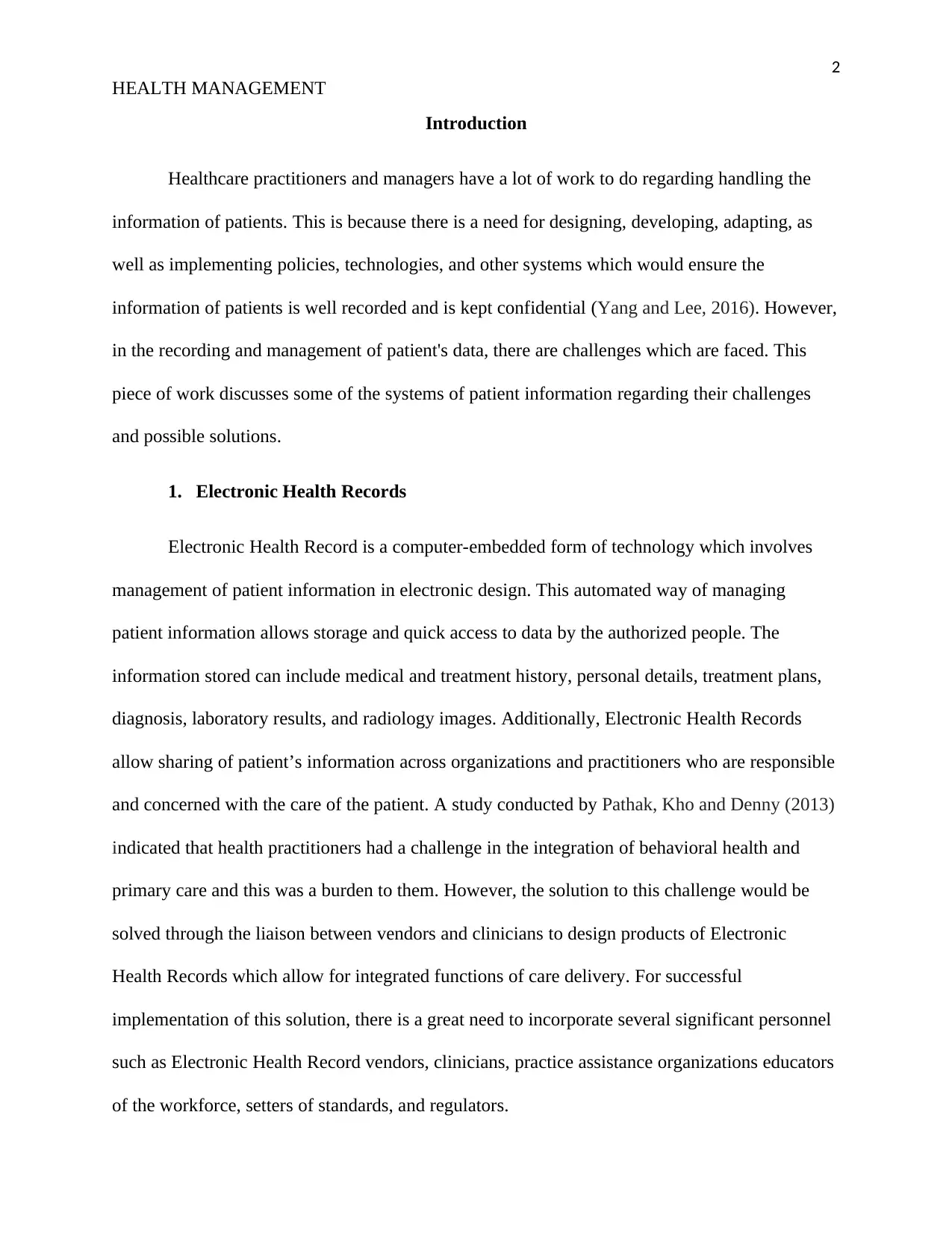
2
HEALTH MANAGEMENT
Introduction
Healthcare practitioners and managers have a lot of work to do regarding handling the
information of patients. This is because there is a need for designing, developing, adapting, as
well as implementing policies, technologies, and other systems which would ensure the
information of patients is well recorded and is kept confidential (Yang and Lee, 2016). However,
in the recording and management of patient's data, there are challenges which are faced. This
piece of work discusses some of the systems of patient information regarding their challenges
and possible solutions.
1. Electronic Health Records
Electronic Health Record is a computer-embedded form of technology which involves
management of patient information in electronic design. This automated way of managing
patient information allows storage and quick access to data by the authorized people. The
information stored can include medical and treatment history, personal details, treatment plans,
diagnosis, laboratory results, and radiology images. Additionally, Electronic Health Records
allow sharing of patient’s information across organizations and practitioners who are responsible
and concerned with the care of the patient. A study conducted by Pathak, Kho and Denny (2013)
indicated that health practitioners had a challenge in the integration of behavioral health and
primary care and this was a burden to them. However, the solution to this challenge would be
solved through the liaison between vendors and clinicians to design products of Electronic
Health Records which allow for integrated functions of care delivery. For successful
implementation of this solution, there is a great need to incorporate several significant personnel
such as Electronic Health Record vendors, clinicians, practice assistance organizations educators
of the workforce, setters of standards, and regulators.
HEALTH MANAGEMENT
Introduction
Healthcare practitioners and managers have a lot of work to do regarding handling the
information of patients. This is because there is a need for designing, developing, adapting, as
well as implementing policies, technologies, and other systems which would ensure the
information of patients is well recorded and is kept confidential (Yang and Lee, 2016). However,
in the recording and management of patient's data, there are challenges which are faced. This
piece of work discusses some of the systems of patient information regarding their challenges
and possible solutions.
1. Electronic Health Records
Electronic Health Record is a computer-embedded form of technology which involves
management of patient information in electronic design. This automated way of managing
patient information allows storage and quick access to data by the authorized people. The
information stored can include medical and treatment history, personal details, treatment plans,
diagnosis, laboratory results, and radiology images. Additionally, Electronic Health Records
allow sharing of patient’s information across organizations and practitioners who are responsible
and concerned with the care of the patient. A study conducted by Pathak, Kho and Denny (2013)
indicated that health practitioners had a challenge in the integration of behavioral health and
primary care and this was a burden to them. However, the solution to this challenge would be
solved through the liaison between vendors and clinicians to design products of Electronic
Health Records which allow for integrated functions of care delivery. For successful
implementation of this solution, there is a great need to incorporate several significant personnel
such as Electronic Health Record vendors, clinicians, practice assistance organizations educators
of the workforce, setters of standards, and regulators.
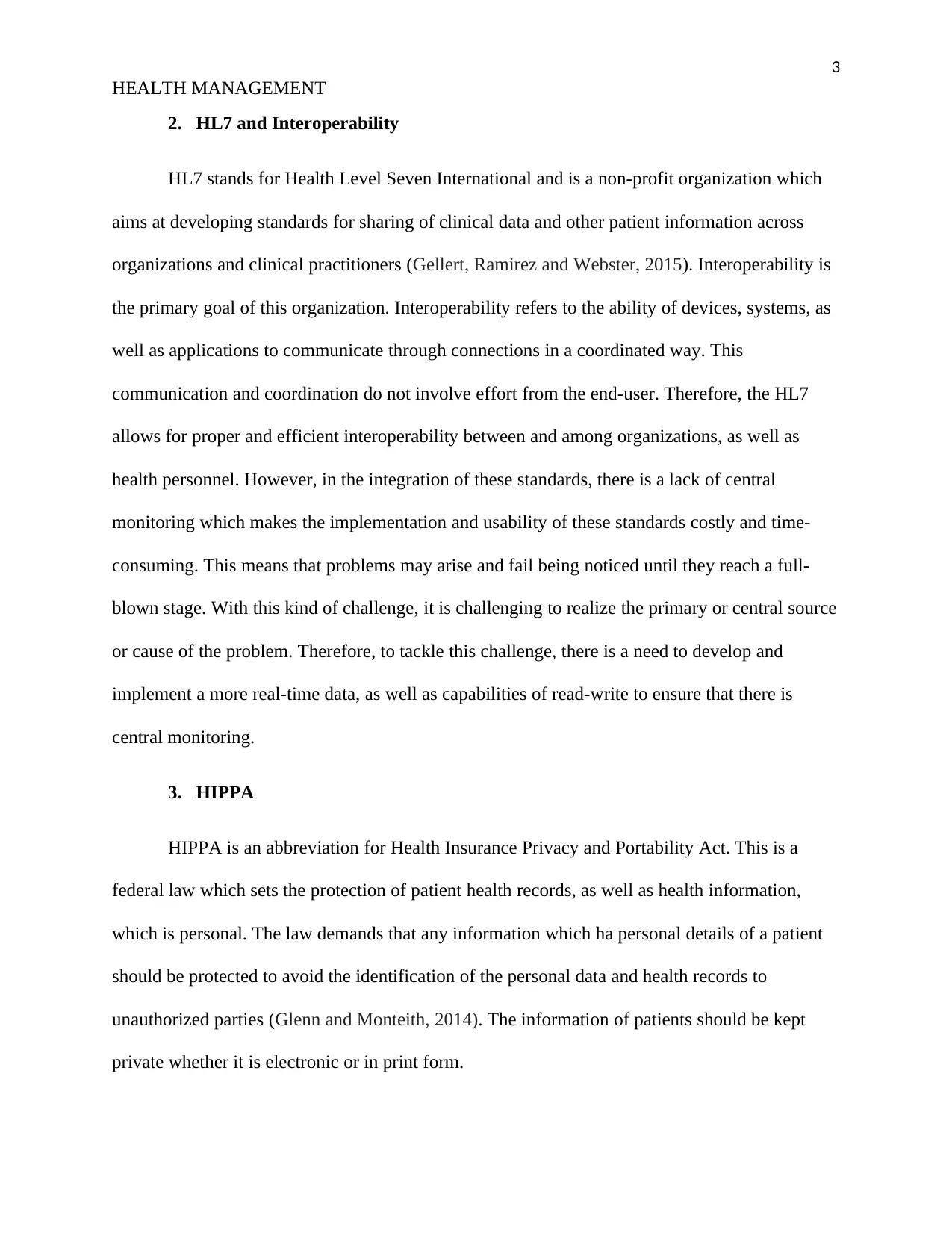
3
HEALTH MANAGEMENT
2. HL7 and Interoperability
HL7 stands for Health Level Seven International and is a non-profit organization which
aims at developing standards for sharing of clinical data and other patient information across
organizations and clinical practitioners (Gellert, Ramirez and Webster, 2015). Interoperability is
the primary goal of this organization. Interoperability refers to the ability of devices, systems, as
well as applications to communicate through connections in a coordinated way. This
communication and coordination do not involve effort from the end-user. Therefore, the HL7
allows for proper and efficient interoperability between and among organizations, as well as
health personnel. However, in the integration of these standards, there is a lack of central
monitoring which makes the implementation and usability of these standards costly and time-
consuming. This means that problems may arise and fail being noticed until they reach a full-
blown stage. With this kind of challenge, it is challenging to realize the primary or central source
or cause of the problem. Therefore, to tackle this challenge, there is a need to develop and
implement a more real-time data, as well as capabilities of read-write to ensure that there is
central monitoring.
3. HIPPA
HIPPA is an abbreviation for Health Insurance Privacy and Portability Act. This is a
federal law which sets the protection of patient health records, as well as health information,
which is personal. The law demands that any information which ha personal details of a patient
should be protected to avoid the identification of the personal data and health records to
unauthorized parties (Glenn and Monteith, 2014). The information of patients should be kept
private whether it is electronic or in print form.
HEALTH MANAGEMENT
2. HL7 and Interoperability
HL7 stands for Health Level Seven International and is a non-profit organization which
aims at developing standards for sharing of clinical data and other patient information across
organizations and clinical practitioners (Gellert, Ramirez and Webster, 2015). Interoperability is
the primary goal of this organization. Interoperability refers to the ability of devices, systems, as
well as applications to communicate through connections in a coordinated way. This
communication and coordination do not involve effort from the end-user. Therefore, the HL7
allows for proper and efficient interoperability between and among organizations, as well as
health personnel. However, in the integration of these standards, there is a lack of central
monitoring which makes the implementation and usability of these standards costly and time-
consuming. This means that problems may arise and fail being noticed until they reach a full-
blown stage. With this kind of challenge, it is challenging to realize the primary or central source
or cause of the problem. Therefore, to tackle this challenge, there is a need to develop and
implement a more real-time data, as well as capabilities of read-write to ensure that there is
central monitoring.
3. HIPPA
HIPPA is an abbreviation for Health Insurance Privacy and Portability Act. This is a
federal law which sets the protection of patient health records, as well as health information,
which is personal. The law demands that any information which ha personal details of a patient
should be protected to avoid the identification of the personal data and health records to
unauthorized parties (Glenn and Monteith, 2014). The information of patients should be kept
private whether it is electronic or in print form.
⊘ This is a preview!⊘
Do you want full access?
Subscribe today to unlock all pages.

Trusted by 1+ million students worldwide
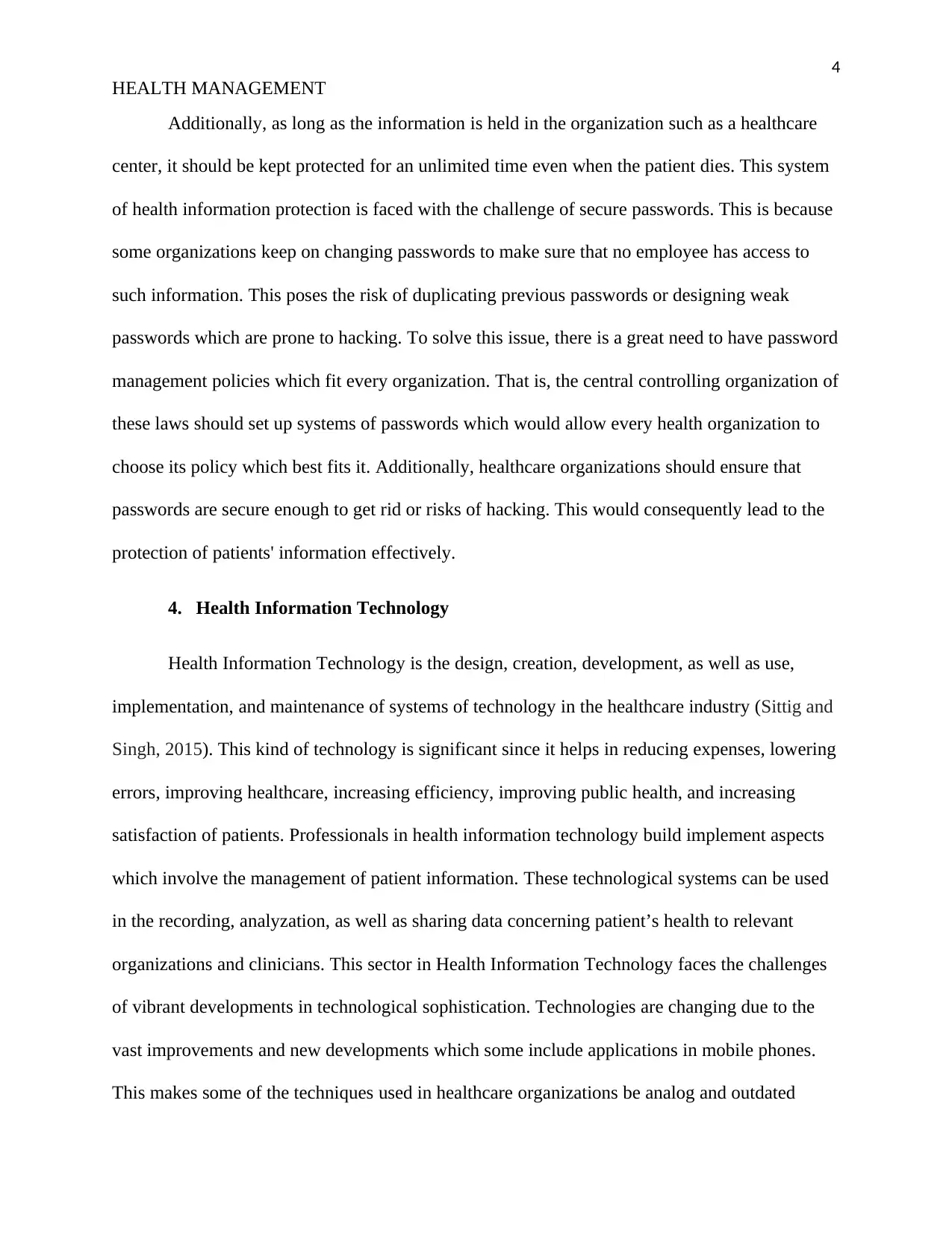
4
HEALTH MANAGEMENT
Additionally, as long as the information is held in the organization such as a healthcare
center, it should be kept protected for an unlimited time even when the patient dies. This system
of health information protection is faced with the challenge of secure passwords. This is because
some organizations keep on changing passwords to make sure that no employee has access to
such information. This poses the risk of duplicating previous passwords or designing weak
passwords which are prone to hacking. To solve this issue, there is a great need to have password
management policies which fit every organization. That is, the central controlling organization of
these laws should set up systems of passwords which would allow every health organization to
choose its policy which best fits it. Additionally, healthcare organizations should ensure that
passwords are secure enough to get rid or risks of hacking. This would consequently lead to the
protection of patients' information effectively.
4. Health Information Technology
Health Information Technology is the design, creation, development, as well as use,
implementation, and maintenance of systems of technology in the healthcare industry (Sittig and
Singh, 2015). This kind of technology is significant since it helps in reducing expenses, lowering
errors, improving healthcare, increasing efficiency, improving public health, and increasing
satisfaction of patients. Professionals in health information technology build implement aspects
which involve the management of patient information. These technological systems can be used
in the recording, analyzation, as well as sharing data concerning patient’s health to relevant
organizations and clinicians. This sector in Health Information Technology faces the challenges
of vibrant developments in technological sophistication. Technologies are changing due to the
vast improvements and new developments which some include applications in mobile phones.
This makes some of the techniques used in healthcare organizations be analog and outdated
HEALTH MANAGEMENT
Additionally, as long as the information is held in the organization such as a healthcare
center, it should be kept protected for an unlimited time even when the patient dies. This system
of health information protection is faced with the challenge of secure passwords. This is because
some organizations keep on changing passwords to make sure that no employee has access to
such information. This poses the risk of duplicating previous passwords or designing weak
passwords which are prone to hacking. To solve this issue, there is a great need to have password
management policies which fit every organization. That is, the central controlling organization of
these laws should set up systems of passwords which would allow every health organization to
choose its policy which best fits it. Additionally, healthcare organizations should ensure that
passwords are secure enough to get rid or risks of hacking. This would consequently lead to the
protection of patients' information effectively.
4. Health Information Technology
Health Information Technology is the design, creation, development, as well as use,
implementation, and maintenance of systems of technology in the healthcare industry (Sittig and
Singh, 2015). This kind of technology is significant since it helps in reducing expenses, lowering
errors, improving healthcare, increasing efficiency, improving public health, and increasing
satisfaction of patients. Professionals in health information technology build implement aspects
which involve the management of patient information. These technological systems can be used
in the recording, analyzation, as well as sharing data concerning patient’s health to relevant
organizations and clinicians. This sector in Health Information Technology faces the challenges
of vibrant developments in technological sophistication. Technologies are changing due to the
vast improvements and new developments which some include applications in mobile phones.
This makes some of the techniques used in healthcare organizations be analog and outdated
Paraphrase This Document
Need a fresh take? Get an instant paraphrase of this document with our AI Paraphraser
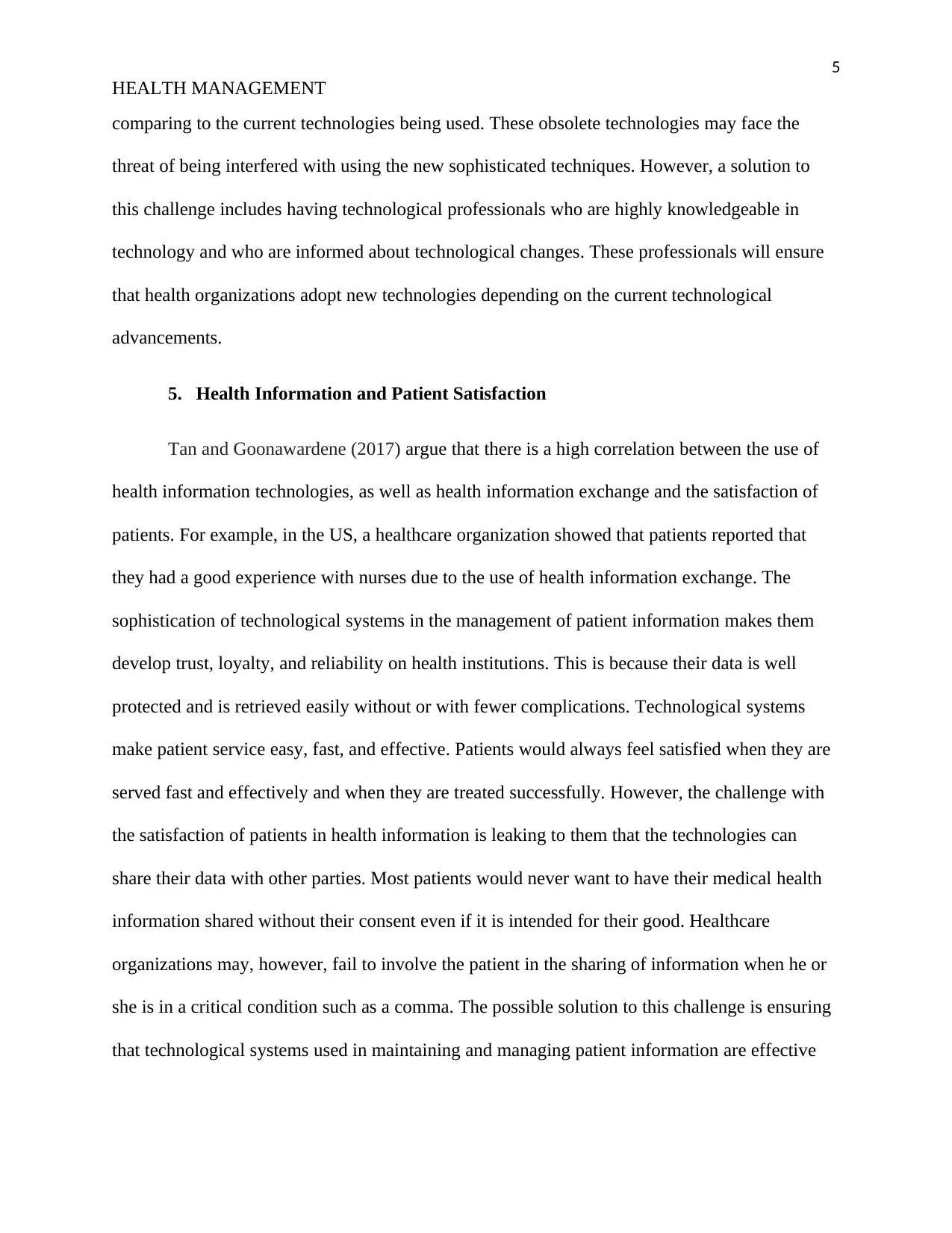
5
HEALTH MANAGEMENT
comparing to the current technologies being used. These obsolete technologies may face the
threat of being interfered with using the new sophisticated techniques. However, a solution to
this challenge includes having technological professionals who are highly knowledgeable in
technology and who are informed about technological changes. These professionals will ensure
that health organizations adopt new technologies depending on the current technological
advancements.
5. Health Information and Patient Satisfaction
Tan and Goonawardene (2017) argue that there is a high correlation between the use of
health information technologies, as well as health information exchange and the satisfaction of
patients. For example, in the US, a healthcare organization showed that patients reported that
they had a good experience with nurses due to the use of health information exchange. The
sophistication of technological systems in the management of patient information makes them
develop trust, loyalty, and reliability on health institutions. This is because their data is well
protected and is retrieved easily without or with fewer complications. Technological systems
make patient service easy, fast, and effective. Patients would always feel satisfied when they are
served fast and effectively and when they are treated successfully. However, the challenge with
the satisfaction of patients in health information is leaking to them that the technologies can
share their data with other parties. Most patients would never want to have their medical health
information shared without their consent even if it is intended for their good. Healthcare
organizations may, however, fail to involve the patient in the sharing of information when he or
she is in a critical condition such as a comma. The possible solution to this challenge is ensuring
that technological systems used in maintaining and managing patient information are effective
HEALTH MANAGEMENT
comparing to the current technologies being used. These obsolete technologies may face the
threat of being interfered with using the new sophisticated techniques. However, a solution to
this challenge includes having technological professionals who are highly knowledgeable in
technology and who are informed about technological changes. These professionals will ensure
that health organizations adopt new technologies depending on the current technological
advancements.
5. Health Information and Patient Satisfaction
Tan and Goonawardene (2017) argue that there is a high correlation between the use of
health information technologies, as well as health information exchange and the satisfaction of
patients. For example, in the US, a healthcare organization showed that patients reported that
they had a good experience with nurses due to the use of health information exchange. The
sophistication of technological systems in the management of patient information makes them
develop trust, loyalty, and reliability on health institutions. This is because their data is well
protected and is retrieved easily without or with fewer complications. Technological systems
make patient service easy, fast, and effective. Patients would always feel satisfied when they are
served fast and effectively and when they are treated successfully. However, the challenge with
the satisfaction of patients in health information is leaking to them that the technologies can
share their data with other parties. Most patients would never want to have their medical health
information shared without their consent even if it is intended for their good. Healthcare
organizations may, however, fail to involve the patient in the sharing of information when he or
she is in a critical condition such as a comma. The possible solution to this challenge is ensuring
that technological systems used in maintaining and managing patient information are effective
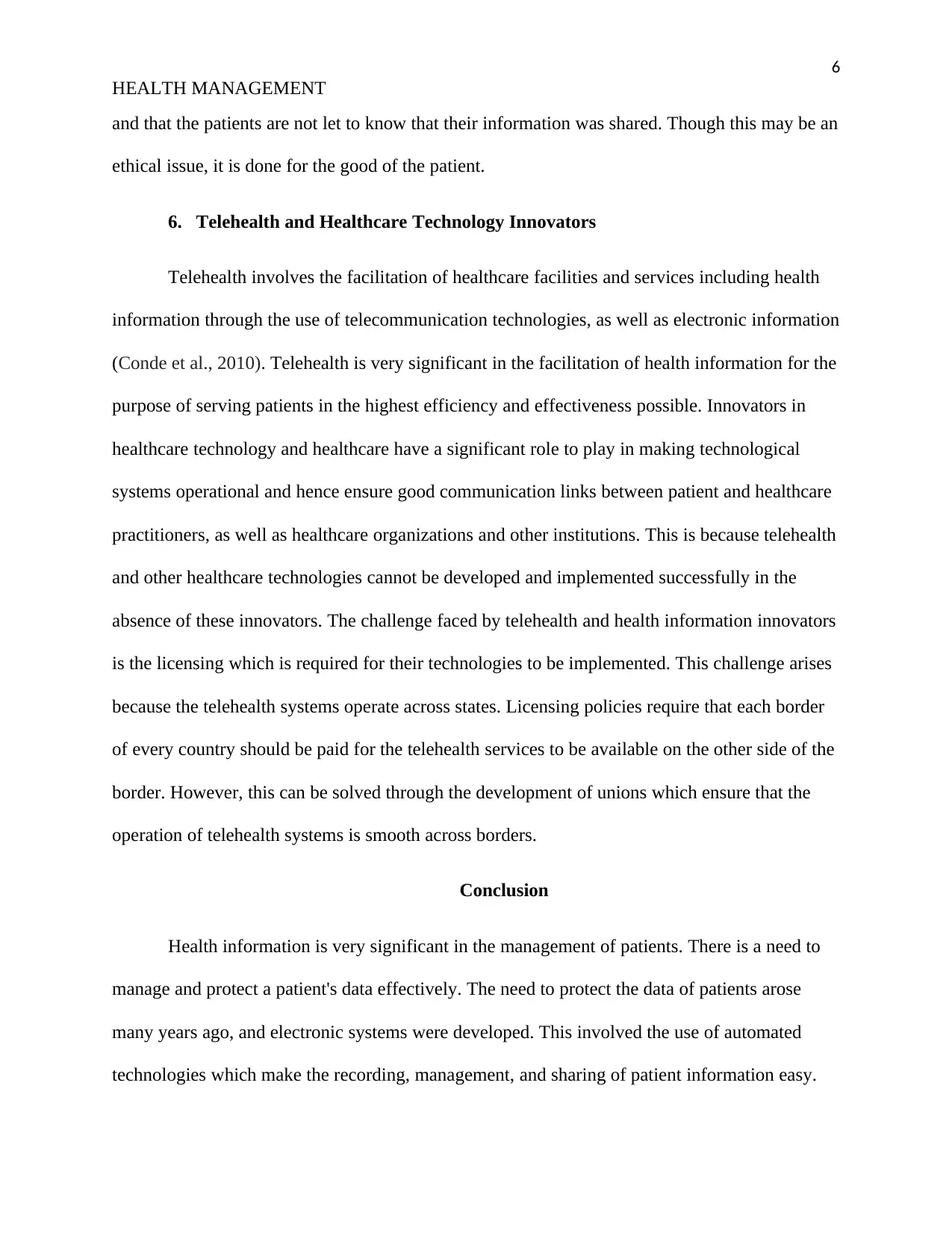
6
HEALTH MANAGEMENT
and that the patients are not let to know that their information was shared. Though this may be an
ethical issue, it is done for the good of the patient.
6. Telehealth and Healthcare Technology Innovators
Telehealth involves the facilitation of healthcare facilities and services including health
information through the use of telecommunication technologies, as well as electronic information
(Conde et al., 2010). Telehealth is very significant in the facilitation of health information for the
purpose of serving patients in the highest efficiency and effectiveness possible. Innovators in
healthcare technology and healthcare have a significant role to play in making technological
systems operational and hence ensure good communication links between patient and healthcare
practitioners, as well as healthcare organizations and other institutions. This is because telehealth
and other healthcare technologies cannot be developed and implemented successfully in the
absence of these innovators. The challenge faced by telehealth and health information innovators
is the licensing which is required for their technologies to be implemented. This challenge arises
because the telehealth systems operate across states. Licensing policies require that each border
of every country should be paid for the telehealth services to be available on the other side of the
border. However, this can be solved through the development of unions which ensure that the
operation of telehealth systems is smooth across borders.
Conclusion
Health information is very significant in the management of patients. There is a need to
manage and protect a patient's data effectively. The need to protect the data of patients arose
many years ago, and electronic systems were developed. This involved the use of automated
technologies which make the recording, management, and sharing of patient information easy.
HEALTH MANAGEMENT
and that the patients are not let to know that their information was shared. Though this may be an
ethical issue, it is done for the good of the patient.
6. Telehealth and Healthcare Technology Innovators
Telehealth involves the facilitation of healthcare facilities and services including health
information through the use of telecommunication technologies, as well as electronic information
(Conde et al., 2010). Telehealth is very significant in the facilitation of health information for the
purpose of serving patients in the highest efficiency and effectiveness possible. Innovators in
healthcare technology and healthcare have a significant role to play in making technological
systems operational and hence ensure good communication links between patient and healthcare
practitioners, as well as healthcare organizations and other institutions. This is because telehealth
and other healthcare technologies cannot be developed and implemented successfully in the
absence of these innovators. The challenge faced by telehealth and health information innovators
is the licensing which is required for their technologies to be implemented. This challenge arises
because the telehealth systems operate across states. Licensing policies require that each border
of every country should be paid for the telehealth services to be available on the other side of the
border. However, this can be solved through the development of unions which ensure that the
operation of telehealth systems is smooth across borders.
Conclusion
Health information is very significant in the management of patients. There is a need to
manage and protect a patient's data effectively. The need to protect the data of patients arose
many years ago, and electronic systems were developed. This involved the use of automated
technologies which make the recording, management, and sharing of patient information easy.
⊘ This is a preview!⊘
Do you want full access?
Subscribe today to unlock all pages.

Trusted by 1+ million students worldwide
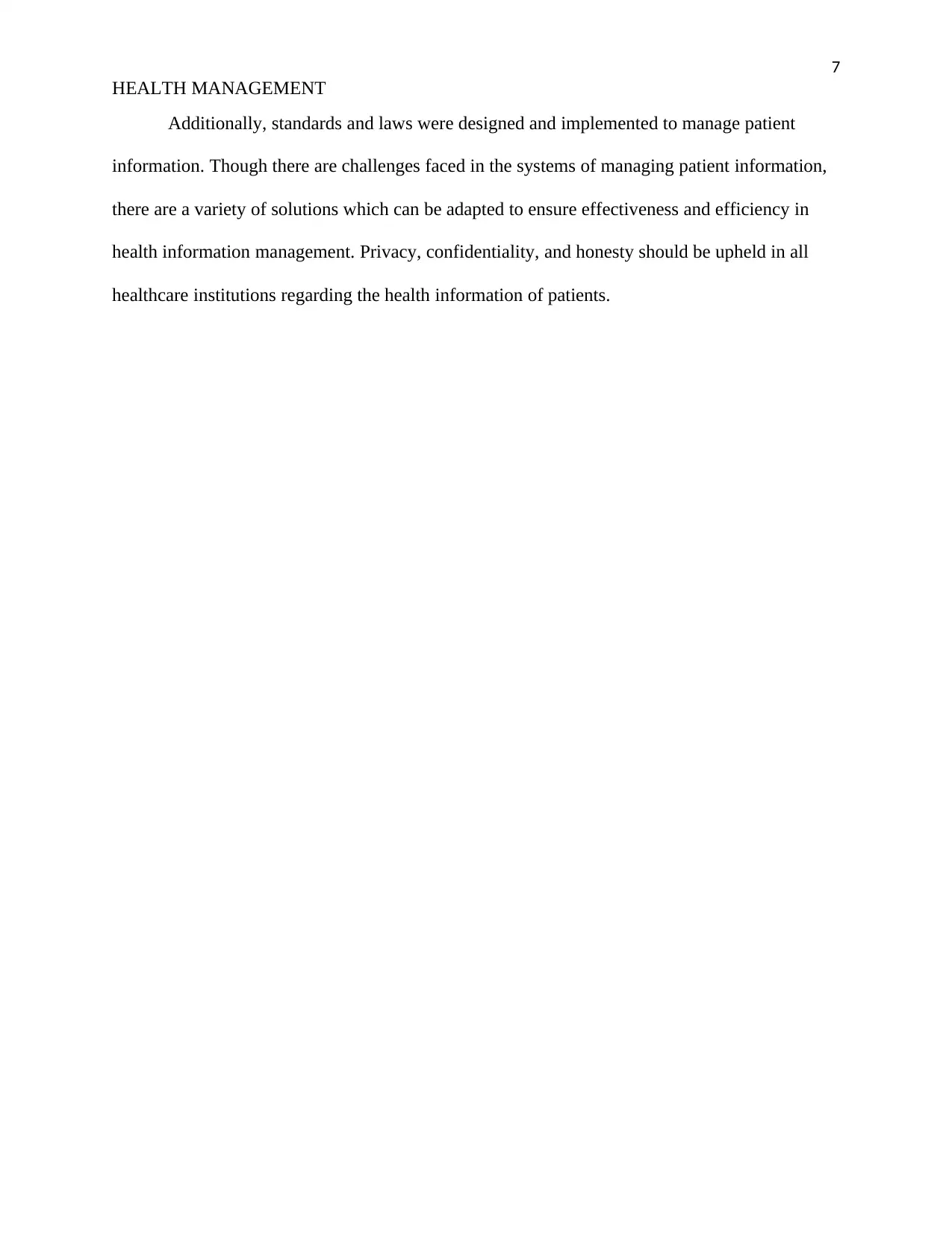
7
HEALTH MANAGEMENT
Additionally, standards and laws were designed and implemented to manage patient
information. Though there are challenges faced in the systems of managing patient information,
there are a variety of solutions which can be adapted to ensure effectiveness and efficiency in
health information management. Privacy, confidentiality, and honesty should be upheld in all
healthcare institutions regarding the health information of patients.
HEALTH MANAGEMENT
Additionally, standards and laws were designed and implemented to manage patient
information. Though there are challenges faced in the systems of managing patient information,
there are a variety of solutions which can be adapted to ensure effectiveness and efficiency in
health information management. Privacy, confidentiality, and honesty should be upheld in all
healthcare institutions regarding the health information of patients.
Paraphrase This Document
Need a fresh take? Get an instant paraphrase of this document with our AI Paraphraser
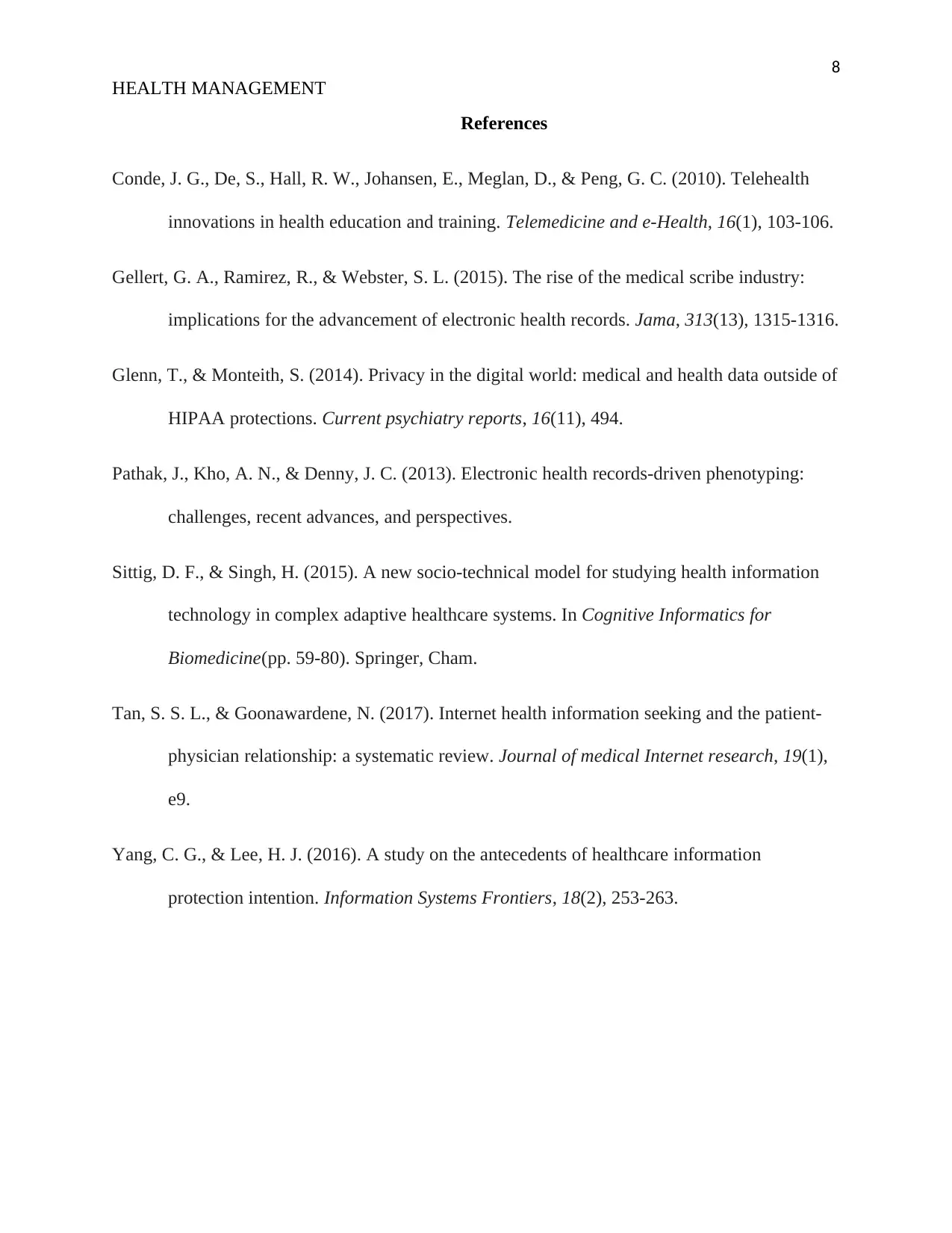
8
HEALTH MANAGEMENT
References
Conde, J. G., De, S., Hall, R. W., Johansen, E., Meglan, D., & Peng, G. C. (2010). Telehealth
innovations in health education and training. Telemedicine and e-Health, 16(1), 103-106.
Gellert, G. A., Ramirez, R., & Webster, S. L. (2015). The rise of the medical scribe industry:
implications for the advancement of electronic health records. Jama, 313(13), 1315-1316.
Glenn, T., & Monteith, S. (2014). Privacy in the digital world: medical and health data outside of
HIPAA protections. Current psychiatry reports, 16(11), 494.
Pathak, J., Kho, A. N., & Denny, J. C. (2013). Electronic health records-driven phenotyping:
challenges, recent advances, and perspectives.
Sittig, D. F., & Singh, H. (2015). A new socio-technical model for studying health information
technology in complex adaptive healthcare systems. In Cognitive Informatics for
Biomedicine(pp. 59-80). Springer, Cham.
Tan, S. S. L., & Goonawardene, N. (2017). Internet health information seeking and the patient-
physician relationship: a systematic review. Journal of medical Internet research, 19(1),
e9.
Yang, C. G., & Lee, H. J. (2016). A study on the antecedents of healthcare information
protection intention. Information Systems Frontiers, 18(2), 253-263.
HEALTH MANAGEMENT
References
Conde, J. G., De, S., Hall, R. W., Johansen, E., Meglan, D., & Peng, G. C. (2010). Telehealth
innovations in health education and training. Telemedicine and e-Health, 16(1), 103-106.
Gellert, G. A., Ramirez, R., & Webster, S. L. (2015). The rise of the medical scribe industry:
implications for the advancement of electronic health records. Jama, 313(13), 1315-1316.
Glenn, T., & Monteith, S. (2014). Privacy in the digital world: medical and health data outside of
HIPAA protections. Current psychiatry reports, 16(11), 494.
Pathak, J., Kho, A. N., & Denny, J. C. (2013). Electronic health records-driven phenotyping:
challenges, recent advances, and perspectives.
Sittig, D. F., & Singh, H. (2015). A new socio-technical model for studying health information
technology in complex adaptive healthcare systems. In Cognitive Informatics for
Biomedicine(pp. 59-80). Springer, Cham.
Tan, S. S. L., & Goonawardene, N. (2017). Internet health information seeking and the patient-
physician relationship: a systematic review. Journal of medical Internet research, 19(1),
e9.
Yang, C. G., & Lee, H. J. (2016). A study on the antecedents of healthcare information
protection intention. Information Systems Frontiers, 18(2), 253-263.
1 out of 8
Related Documents
Your All-in-One AI-Powered Toolkit for Academic Success.
+13062052269
info@desklib.com
Available 24*7 on WhatsApp / Email
![[object Object]](/_next/static/media/star-bottom.7253800d.svg)
Unlock your academic potential
Copyright © 2020–2025 A2Z Services. All Rights Reserved. Developed and managed by ZUCOL.





